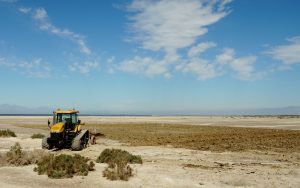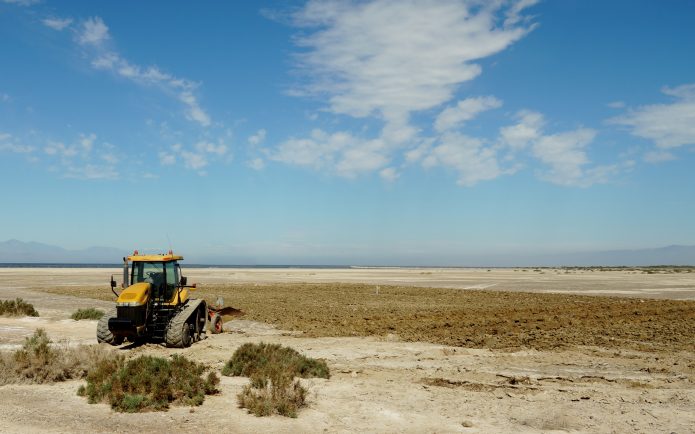
A tractor plows along the southeastern shore of the Salton Sea as part of the surface roughening pilot project–one of the methods being studied for dust suppression.
Last week, the parties of the Quantification Settlement Agreement Joint Powers Authority—San Diego County Water Authority, Imperial Irrigation District, Coachella Valley Water District, and the State of California—unanimously approved a $25.5 million budget for fiscal year 2018. This is significant in advancing the efforts toward mitigation at the Salton Sea as it relates to the QSA water transfers. The majority of the funding will go toward the final mitigation conservation effort to supply water to the Sea and a new round of proactive air quality projects.
The JPA was established to address an array of environmental mitigation requirements—the Salton Sea among them—as part of the Water Right Order that permitted the implementation of the QSA. The water agencies funding is limited to $133 million (in 2003 dollars—actually $287 million over the life of the QSA) for mitigation. The State has a responsibility to cover mitigation costs that exceed that water agencies’ funding cap. From the start, the JPA has met its funding and mitigation obligations annually with the majority of those funds used for a 15-year fallowing program to generate mitigation water for the Sea. Funding has also paid for the placement of six air quality monitoring stations around the Sea, the development of a 900 acre-managed marsh and a host of other environmental projects. Additionally, the JPA is developing a series of air quality projects to address potential dust emissions when mitigation flows end in 2018—and this year the largest percent of the budget will go toward such air quality projects. Planned air quality expenditures will cover costs associated with playa monitoring and modeling, the air stations monitoring network, an emissions inventory, and on-the-ground dust control measures.
If you spend any time near Red Hill Marina or other sections along the Sea’s southeast rim, you will see the projects that have been done to date with JPA funds. One project has involved ground surface roughening to create ridges and furrows in the playa that prevent wind-swept dust from occurring. Another project has been to plant vegetation to cover exposed playa, and findings so far indicate with very little water, vegetation will grow. A third project has involved the use of a surfactant—a kind of ground coverage spray—to prevent dust. All of these are proven measures. Under the recently adopted budget, these projects will be expanded and the knowledge gained from these initial projects will provide a path forward. These early projects are critical because they will determine which methods to address mitigation are most cost effective.
There is much discussion, and rightly so, about what will happen at the Salton Sea in 2018 when mitigation flows end. It is important to remember, the JPA will continue to move forward with air quality projects to address any playa exposures related to the QSA that are found to be emissive. It is also important to remember that such exposure will not occur all at once but over years and that not all exposed playa will be emissive. The environmental program established under the QSA regulations and permits to address these issues and the responsibilities of the JPA and the State toward mitigation are well documented.
As has been mentioned many times, the issue of Salton Sea restoration is a separate and larger matter than QSA mitigation—tied to the Sea’s longstanding environmental troubles, and is an issue that would have to be addressed with or without the QSA. Restoration remains a State responsibility and the Water Authority, along with its QSA JPA partners, will continue to push the State to meet that obligation. The State’s proposed ten-year management program is a good first step but there needs to be greater commitment on the part of the State toward Restoration funding. In the meantime, the JPA will continue to meet its mitigation requirements as it has from the start of the QSA in 2003.
